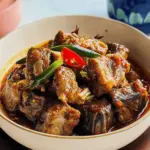Pork schnitzel is a classic dish that originates from Austria and Germany, known for its crispy golden crust and tender, juicy meat inside. It’s a simple yet flavorful meal made with thinly pounded pork cutlets that are breaded and fried. Perfectly paired with lemon wedges and garnished with fresh parsley, it’s a satisfying dish suitable for any occasion.
Full Recipe:
Ingredients
-
4 boneless pork chops (pounded to ¼-inch thickness)
-
1 cup all-purpose flour
-
2 large eggs
-
2 tablespoons milk
-
1 ½ cups breadcrumbs (preferably panko for extra crunch)
-
1 teaspoon salt
-
½ teaspoon black pepper
-
½ teaspoon garlic powder (optional)
-
½ teaspoon paprika (optional)
-
½ cup vegetable oil (for frying)
-
Lemon wedges (for serving)
-
Fresh parsley (for garnish, optional)
Directions
-
Prepare the Pork Cutlets: Place each pork chop between two sheets of plastic wrap or parchment paper. Use a meat mallet or rolling pin to pound the pork to about ¼-inch thickness.
-
Set Up the Breading Station: Prepare three shallow bowls. In the first bowl, add the flour. In the second, whisk the eggs and milk. In the third, combine breadcrumbs, salt, pepper, garlic powder, and paprika.
-
Bread the Pork Cutlets: Coat each pork cutlet first with flour, then dip into the egg mixture, and finally coat in the breadcrumb mixture, pressing gently to ensure it sticks.
-
Heat the Oil: Heat vegetable oil in a large skillet over medium-high heat. Test the oil by dropping a small breadcrumb in—if it sizzles immediately, it’s ready.
-
Fry the Schnitzel: Fry the breaded pork cutlets for 3-4 minutes per side, or until golden brown and crispy. Avoid overcrowding the pan.
-
Drain and Serve: Remove the schnitzels from the oil and place on paper towels to drain excess oil. Serve immediately with lemon wedges and fresh parsley for garnish.
Nutrients (Per Serving)
-
Calories: 450
-
Protein: 35g
-
Carbohydrates: 30g
-
Fat: 22g
-
Fiber: 2g
-
Sodium: 600mg
History and Origins of Pork Schnitzel
The roots of schnitzel can be traced back to Austria and Germany, where it is considered a classic dish. The origins of schnitzel are often debated, with some attributing it to Vienna, Austria, and others claiming it has Italian or even Middle Eastern influences. The term “schnitzel” itself comes from the German word “Schnitt,” which means “cut,” referring to the thin, sliced meat used in the dish. While veal was originally the meat of choice for schnitzels, over time, pork became a more affordable and accessible alternative, especially in regions where pork is more commonly raised.
Pork schnitzel gained significant popularity in the 19th century and has since become a comfort food favorite in many countries. In Germany, it is known as “Schweineschnitzel,” while in Austria, it is commonly referred to as “Wiener Schnitzel,” though the latter term is often reserved for veal versions. Over time, variations of schnitzel have appeared in other countries, including Hungary, the Czech Republic, and even the United States, where it has been embraced as a hearty meal.
The Key Elements of Pork Schnitzel
The success of pork schnitzel lies in the balance between its crispy, golden crust and the tender, juicy meat inside. The key to achieving this perfect balance is the preparation of the pork cutlets. The pork should be pounded thin to ensure even cooking, which helps retain moisture while achieving a crisp coating. This step also tenderizes the meat, making it more enjoyable to eat.
The breading process is another critical element in making schnitzel. Typically, three components are used: flour, eggs, and breadcrumbs. The flour helps the egg mixture adhere to the meat, while the egg wash binds the breadcrumbs, which form the crunchy crust when fried. The choice of breadcrumbs is important, as panko breadcrumbs are often preferred for their light, airy texture and ability to provide an extra-crispy finish.
The seasoning of the breading mixture is another way to enhance the flavor of the dish. While salt and pepper are essential, many recipes include garlic powder, paprika, or other spices to elevate the taste. These subtle additions help bring out the rich flavors of the pork without overpowering the dish. A squeeze of fresh lemon juice just before serving brightens up the flavors and adds a zesty contrast to the richness of the fried cutlet.
Preparing Pork Schnitzel at Home
Making pork schnitzel at home is a straightforward process that doesn’t require specialized skills, but there are some tips to ensure the best results. Start by selecting high-quality boneless pork chops. Look for meat that has a good amount of marbling for tenderness and flavor. The pork should be pounded thin, ideally to about ¼-inch thickness. This ensures that the cutlets cook quickly and evenly, avoiding the risk of overcooking the meat.
Once the pork is prepared, the breading station comes next. Set up three shallow bowls: one for flour, one for the egg wash (eggs mixed with a bit of milk), and one for the breadcrumb mixture. It’s important to coat each cutlet thoroughly in the flour, then dip it into the egg wash, and finally press it into the breadcrumbs. The more even and generous the coating, the crispier the result.
When frying the schnitzels, the oil temperature is crucial. If the oil is too hot, the schnitzels will burn before they cook through; too cold, and the breading will absorb too much oil, making the dish greasy. Aim for medium-high heat and test the oil by dropping in a small amount of breadcrumbs—if they sizzle immediately, the oil is ready. Fry the schnitzels for 3-4 minutes on each side, or until golden brown and crisp.
After frying, allow the schnitzels to drain on paper towels to remove excess oil. This step ensures that the final dish remains light and crispy. Serve immediately, garnished with fresh parsley and accompanied by lemon wedges for squeezing over the schnitzels. The lemon not only adds a burst of freshness but also helps balance the richness of the fried cutlet.
Variations and Serving Suggestions
While the traditional pork schnitzel is delicious on its own, there are numerous variations and accompaniments that can take the dish to the next level. In Germany, schnitzels are often served with a side of potato salad, sauerkraut, or boiled potatoes. These sides complement the dish’s richness and provide a satisfying contrast in textures.
In Austria, a classic accompaniment is a side of lingonberry jam, which adds a touch of sweetness to the savory dish. Some variations of schnitzel also include toppings such as a fried egg or a rich mushroom sauce. In some regions, schnitzels are served with a side of rösti, a crispy Swiss-style potato dish that pairs wonderfully with the fried cutlets.
For a lighter option, consider serving the schnitzel with a crisp salad or steamed vegetables. The bright acidity of the salad or the gentle sweetness of steamed vegetables can provide a nice counterbalance to the heaviness of the fried pork.
Another popular variation is to prepare the schnitzel as a “sandwich” by placing the fried cutlet between two slices of bread or in a bun. This is a common practice in many parts of the world, especially in Austria, where it is known as a “Schnitzelburger.” The sandwich is often topped with salad, mustard, and pickles, making it a deliciously hearty meal.
Conclusion: The Appeal of Pork Schnitzel
Pork schnitzel is a timeless dish that continues to capture the hearts and appetites of people worldwide. With its crispy exterior and tender, juicy interior, it is no wonder that schnitzel has become a favorite in many cultures. Whether you’re enjoying it in its simplest form with a squeeze of lemon and a sprinkle of parsley or pairing it with a variety of sides and sauces, pork schnitzel is a versatile and satisfying meal that appeals to all ages.
Its relatively simple preparation and the ability to customize it to personal taste make it an excellent choice for home cooks looking to prepare a dish that is both comforting and impressive. Whether served for a weeknight dinner or a special occasion, pork schnitzel is sure to please. By following a few essential steps and adding your personal touch, you can create a delicious version of this classic dish that will become a favorite in your kitchen as well.








